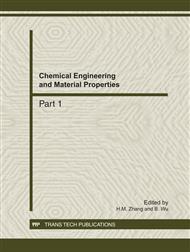p.1311
p.1315
p.1319
p.1324
p.1330
p.1334
p.1338
p.1342
p.1346
Effect of Ultrasound on Acid-Alcohol Treated Hydrolysis of Starch
Abstract:
Excessive intake of fat will damage human health seriously, and it can also cause obesity, high blood pressure, atherosclerosis and coronary heart disease. So low fat foods gradually become highly widespread. As a result, fat substitutes are focused, which have the same physical and sensory properties as fat, and can be used in place of fat in many cases. In this work, fat substitute was prepared by acid-alcohol treated hydrolysis of corn starch with and without ultrasound. Some factors affecting the DE of starch hydrolysate were investigated by experiments with and without ultrasound, including reaction temperature, time, ethanol concentration, and hydrochloric acid concentration. Enhancements of the hydrolysis by ultrasound was observed.The results showed that the DE increased with the rise of reaction temperature, time and hydrochloric acid concentration. However, it decreased as the increase of alcohol concentration. Ultrasound can accelerate the hydrolysis evidently, and increased the DE by at least 22.22%.
Info:
Periodical:
Pages:
1330-1333
Citation:
Online since:
December 2011
Keywords:
Price:
Сopyright:
© 2012 Trans Tech Publications Ltd. All Rights Reserved
Share:
Citation:


